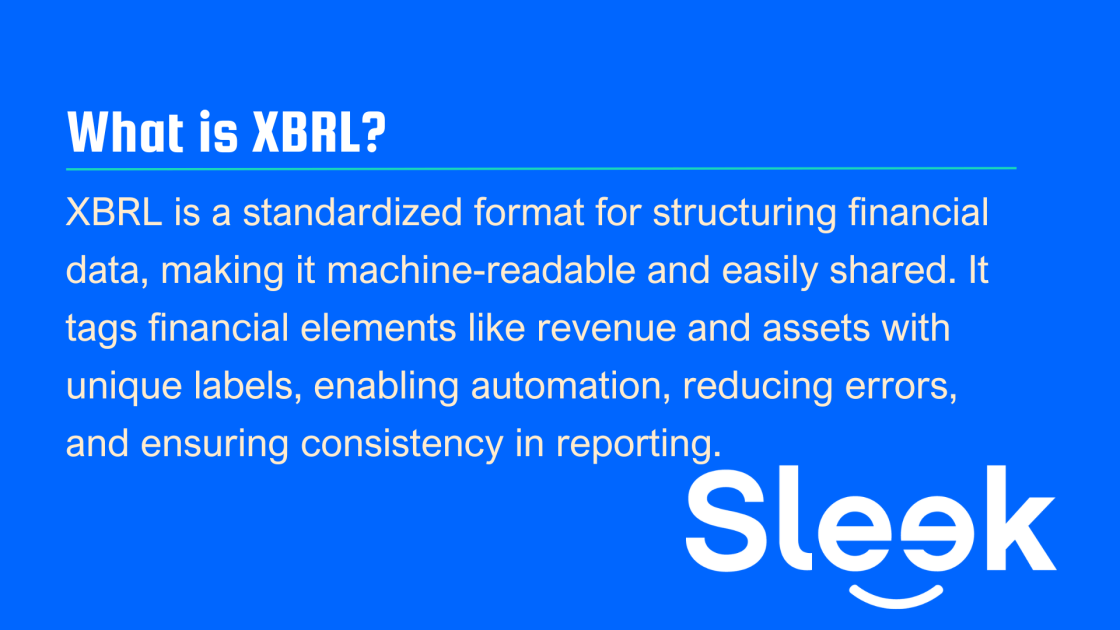Filing financial statements in Singapore?
XBRL (eXtensible Business Reporting Language) is the required format by ACRA for structured and machine-readable financial reporting. Learn more about XBRL financial reporting here!
What is XBRL?
XBRL (eXtensible Business Reporting Language) is a standardised format for structuring financial data, making it machine-readable and easily shared across different systems. Instead of manually entering data from spreadsheets or reports, XBRL tags each financial element—such as revenue, assets, or liabilities—with a unique, standardised label. This allows automated processing, reduces errors, and ensures consistency in financial reporting. Many regulators, including ACRA in Singapore, require companies to file financial statements in XBRL format.
Learn more about the difference between XBRL and traditional financial reporting here!
Who needs to file XBRL in Singapore?
Companies in Singapore must file their financial statements in XBRL format with ACRA, depending on their type and financial status.
1. Listed and non-listed companies
- Listed companies must hold their AGM within 4 months after their financial year-end (FYE) and file their Annual Return (including XBRL financial statements) within 5 months after their FYE.
- Non-listed solvent companies must hold their AGM within 6 months after their FYE and file their Annual Return within 7 months, unless they qualify for a shorter deadline.
2. Insolvent companies (exempt private companies – EPCs)
- Insolvent EPCs must file unaudited financial statements in XBRL format within 30 days of their AGM, but no later than 6 months after their FYE.
Key considerations
- Deadlines are based on the company’s FYE, not the calendar year.
- Filing is done through ACRA’s BizFile+ portal.
- Extensions may be granted in special cases, but they are not automatic.
- Late filing results in penalties, which increase the longer the delay.
For first-time filers, companies must submit their Annual Return within 18 months of incorporation or 30 days after their first AGM, whichever comes first.
XBRL filing deadlines example
In this XBRL filing deadline example, we assume the financial year end is on December 31st.
Company Type | AGM Deadline | Annual Return (with XBRL) Filing Deadline |
Listed Company | April 30th | May 31st |
Non-Listed Company | June 30th | July 31st |
Unlock your hassle-free XBRL filing in seconds.
How to do XBRL filing
The XBRL filing process in Singapore, while seemingly complex, can be broken down into manageable steps. This guide outlines the typical process for submitting your XBRL financial statements to ACRA through BizFile+:
Step 1: Prepare financial statements
Ensure your company’s financial statements are complete and accurate, complying with the relevant Singapore Financial Reporting Standards (SFRS, SFRS for Small Entities, or Companies Act requirements).
If your company is subject to statutory audit, ensure the audit is completed and the auditor’s report is available.
Step 2: Choose your XBRL preparation method
- In-house Preparation: If you have the internal expertise and resources, you can prepare the XBRL file yourself using XBRL preparation software.
- Outsourcing: Engage a professional accounting service provider like Sleek to handle the XBRL conversion and filing process. This is often the most efficient and reliable option, especially for companies new to XBRL or those with complex financial statements.
- Software Selection: Choose XBRL preparation software that is compatible with the current ACRA Taxonomy and supports the required filing option (Full XBRL or XBRL FSH).
Step 3: Convert financial statements to XBRL
Using your chosen software, map the data elements from your financial statements to the corresponding tags in the ACRA Taxonomy. This is the core of the XBRL conversion process.
Apply the appropriate XBRL tags to each data point. Ensure you comply with the Minimum Requirement List (MRL) for your chosen filing option.
Use the software’s built-in validation features to check for errors and ensure the XBRL file complies with the ACRA Taxonomy. This step is crucial to avoid filing rejections.
Step 4: Prepare Supporting Documents (if applicable)
Prepare PDF versions of any required supporting documents, such as the director’s report, auditor’s report, and the complete set of financial statements (if filing XBRL FSH Option 2).
Step 5: Login to BizFile+
- CorpPass Access: Access the BizFile+ portal (www.bizfile.gov.sg) using your CorpPass credentials.
- Select Filing Type: Navigate to the appropriate section for filing Annual Returns and financial statements.
Step 6: Upload XBRL file and supporting documents
Upload the validated XBRL file and any required PDF documents. Carefully review the uploaded information to ensure accuracy.
Step 7: Make payment (if applicable)
Pay any applicable filing fees to ACRA through BizFile+. The fees vary depending on the type of filing.
Step 8: Submit filing
Submit the filing and obtain confirmation from ACRA. Keep a record of the submission confirmation for your records.
Step 9: Monitor filing status
- BizFile+ Notifications: Monitor BizFile+ for any notifications or updates regarding your filing. ACRA may request clarifications or amendments if there are any issues.
- Address Queries: Respond promptly to any queries from ACRA.
Step 10: Recordkeeping
Maintain records, such as financial statements, XBRL files, and confirmation of filing for future reference.
XBRL filing requirements
Companies in Singapore must submit their financial statements in XBRL format as part of their Annual Return (AR) filing with ACRA; and meeting XBRL filing requirements in Singapore is more than just uploading a file.
Your own XBRL filing requirements will depend on the company type, size, and financial status.
Here’s a clear breakdown of the key requirements:
Filing Portal
All XBRL filings must be submitted online through ACRA’s BizFile+ portal. No paper submissions are accepted. You will need a CorpPass account to access BizFile+.
XBRL Format
The financial statements must be prepared in accordance with the ACRA Taxonomy. This taxonomy defines the specific data elements (tags) and reporting rules that must be followed. The current taxonomy is based on the Singapore Financial Reporting Standards (International) (SFRS(I)s) and SFRS for Small Entities. The SFRS(I)s are closely modeled after the International Financial Reporting Standards (IFRS).
Full XBRL vs. Simplified XBRL FSH (Financial Statement Highlights)
|
Feature |
Full XBRL |
XBRL FSH |
|
Who is it for? |
Most companies, including larger and/or public companies. Required unless specific exemptions apply. |
Smaller companies that meet specific criteria under Section 205C of the Companies Act (Cap. 50). |
|
Filing Options |
Single filing option. |
Two Options: Option 1: Reduced data set (Financial Statement Highlights).
Option 2: Full PDF financials + key data in XBRL. |
|
Data Tagging |
All relevant data points within the complete set of financial statements must be tagged. |
Option 1: A reduced set of mandatory data points (primarily from the Statement of Financial Position and Statement of Comprehensive Income) must be tagged.
Option 2: Key data elements from Statment of Financial Position and Statement of Comprehensive Income |
|
Complexity |
More complex and time-consuming due to the extensive tagging requirements. |
Option 1: Less complex than Full XBRL due to reduced tagging.
Option 2: Requires creation of both full PDF and XBRL for Key Data |
|
Software |
Requires XBRL preparation software capable of handling the full ACRA Taxonomy. |
Requires XBRL preparation software, but simpler tools might suffice for Option 1. |
|
Financial Statements |
Requires Complete Set of Financial Statements. |
Option 1: XBRL FSH (Key Data).
Option 2: Requires Complete set of Financial Statements (PDF) and Key Data (XBRL) |
Minimum Requirement List (MRL)
The ACRA Taxonomy includes a Minimum Requirement List, which specifies the mandatory data elements that must be tagged. Failure to tag these elements will result in filing rejection.
Data Accuracy
The data submitted in XBRL format must be accurate and consistent with the company’s audited financial statements (if applicable). Any discrepancies can lead to penalties.
Preparation Software
You will need to use XBRL preparation software to create the XBRL file. This software helps you tag the data and validate it against the ACRA Taxonomy. Several options are available, ranging from free online tools (for very simple filings) to paid software packages offered by various vendors. Sleek partners with such vendors.
Audited vs. Unaudited Financial Statements
- If your company is required to have its financial statements audited, the XBRL file must reflect the audited figures.
- If your company is exempt from audit, the XBRL file should be based on the unaudited financial statements.
Supporting Documents
While the XBRL file contains the core financial data, you may also need to submit other supporting documents in PDF format through BizFile+, such as the director’s report and the auditor’s report (if applicable).
Complete Set of Financial Statements
A complete set of financial statements generally includes:
- Statement of Comprehensive Income
- Statement of Financial Position
- Statement of Cash Flows
- Statement of Changes in Equity
- Notes to the financial statements.
Compliance with SFRS(I)s or SFRS for Small Entities
It’s crucial to remember that XBRL is a reporting format. The underlying financial statements themselves must still comply with all applicable Singapore Financial Reporting Standards (International) (SFRS(I)s) or SFRS for Small Entities.
Who is exempt from XBRL filing in Singapore?
While most companies must file financial statements in XBRL format, some are exempt based on their type, size, or industry. Here are the main exemptions:
- Insolvent Exempt Private Companies (EPCs)
If a company’s liabilities exceed its assets, it is considered insolvent and does not need to file in XBRL. Instead, it must submit financial statements and an auditor’s report (if applicable) in PDF format via BizFile+. A declaration of solvency status is also required.
- Solvent Exempt Private Companies (EPCs)
Solvent EPCs must file in XBRL. They can use XBRL FSH Option 1 if they qualify as a small company under the Companies Act.
- Dormant Companies
A dormant EPC is exempt from XBRL filing. Dormant companies that are not EPCs must still file in XBRL but may qualify for XBRL FSH Option 1 if classified as a small company.
- Companies in Regulated Industries
Certain industries have separate financial reporting requirements that override XBRL filing:
- Banks and Finance Companies – Regulated by the Monetary Authority of Singapore (MAS).
- Insurance Companies – Also regulated by MAS, with industry-specific reporting rules.
XBRL format explained
XBRL (eXtensible Business Reporting Language) is a key tool for standardizing the way companies report financial information. This digital format ensures that financial data is not only accessible but also comparable across different entities.
XBRL Taxonomy and instance documents
The XBRL Taxonomy consists of a dictionary of accounting terms relevant to the specific reporting requirements. In Singapore, the taxonomy is adapted to meet local statutory requirements and includes elements that represent the financial information that companies need to submit to ACRA.
Instance documents are the actual XBRL files containing the financial data for a specific period. These documents use the taxonomy as a reference to ensure that all data is correctly tagged and structured. The instance document embeds values for each taxonomy element, providing a clear and accurate representation of a company’s financial state.
XBRL Tagging: How it works
XBRL tagging involves assigning tags from the XBRL taxonomy to specific items within a company’s financial statements. Each tag corresponds to a particular data element within the taxonomy. This process ensures that the data conveyed in financial statements is captured accurately and consistently in a manner that can be understood and processed by software systems.
Tagging can be done using software tools that support the XBRL format, which simplifies the process of preparing financial reports for submission. In Singapore, companies are generally required to tag their financial statements in XBRL format before filing them with ACRA.
Examples of XBRL format
Here are some simplified examples of how XBRL tagging might appear in a financial statement:
- Assets: Each asset item, such as cash, inventories, and property, plant, and equipment, will have a corresponding XBRL tag that categorizes and describes the item according to the taxonomy.
- Liabilities: Similar to assets, liabilities such as loans, accounts payable, and other financial obligations are tagged to reflect their nature and status as per the taxonomy.
- Revenue and Expenses: Revenue streams and expense categories are also tagged to facilitate detailed and standardized reporting.
Through these examples, it’s clear how XBRL helps in standardizing financial reporting and making it easier to analyze and compare financial information across different entities and reporting periods.
What is the difference between XBRL and iXBRL?
While both XBRL and iXBRL (Inline XBRL) are related to financial reporting using the XBRL standard, they differ significantly in how they combine human-readable presentation with machine-readable data. The key difference lies in their format and how they are intended to be used.
Think of XBRL as the ingredients list and nutritional information on a food package. It’s precise and standardized data, but it’s not very appetizing on its own. iXBRL is like the fully prepared meal, presented on a plate, with the nutritional information (the XBRL tags) discreetly embedded within the presentation. You can enjoy the meal (read the report) without needing to decipher the raw ingredients list, but the information is still there for analysis if needed.
Key Differences Summarized:
| Feature | XBRL | iXBRL |
| Format | XML | HTML with embedded XBRL tags |
| Human-Readability | No (requires separate viewer) | Yes (viewable in a web browser) |
| Presentation | Data only; no formatting | Combines data and presentation |
| Primary Use | Machine-to-machine data exchange | Human consumption and machine processing |
| Complexity | Simpler file structure (data only) | More complex file structure (data + presentation) |
How Sleek simplifies XBRL filing
Sleek eliminates XBRL filing headaches. Our expert team handles everything: converting your financial statements to the correct XBRL format, validating against ACRA’s taxonomy, and submitting through BizFile+. We ensure timely, accurate filings, using ACRA-approved software. Focus on your business, not compliance complexities.
Get a personalized quote and experience stress-free XBRL filing with Sleek.
Unlock your hassle-free XBRL filing in seconds.
Conclusion
XBRL filing in Singapore is a defined process with specific requirements set by ACRA. Understanding the difference between Full XBRL and XBRL FSH, knowing who is exempt, and adhering to deadlines are crucial for compliance. Utilizing appropriate software and carefully following ACRA’s guidelines are essential steps. Accurate and timely filing, based on a company’s specific circumstances, is paramount to avoid penalties and ensure proper financial reporting in Singapore.
Frequently asked questions about XBRL
What are the penalties for late XBRL filing in Singapore?
ACRA imposes penalties for late filing of Annual Returns, which include the XBRL financial statements. The penalty is a flat rate of S$300 for any breach of the Annual Return filing requirements. This applies regardless of how many days late the submission is. It’s a single penalty per Annual Return, not a per-day or escalating penalty. However, persistent non-compliance can lead to further action from ACRA, including prosecution of company directors. It is therefore crucial to file on time.
How much does it cost to file XBRL?
The cost of XBRL filing varies significantly depending on several factors:
- Preparation Method: Doing it in-house with free software is the cheapest option (but requires significant expertise). Outsourcing to a service provider like Sleek is more expensive, but saves time and reduces the risk of errors.
- Complexity of Financial Statements: Companies with simple financial statements will generally pay less than those with complex transactions and numerous disclosures.
- Software Used: Some XBRL preparation software is free (for basic filings), while others require paid licenses.
- Service Provider Fees: If you outsource, the service provider’s fees will depend on the scope of work and their pricing structure. Sleek offers competitive and transparent pricing.
- ACRA Filing Fee: There is a S$60 fee for filing the annual return.
Therefore, it’s impossible to give a single cost figure. It’s best to get quotes from service providers or estimate the cost of software and internal resources if preparing in-house.
What software do I need for XBRL filing?
You need XBRL preparation software that is compatible with the current ACRA Taxonomy. This software allows you to map your financial statement data to the appropriate XBRL tags and validate the file before submission. There are several options available:
- Free Online Tools: ACRA provides BizFin<sup>x</sup> preparation tool, which is available online. This is best suited for very simple filings.
- Paid Software Packages: Several vendors offer paid XBRL software with more advanced features, such as automated tagging, validation checks, and support for complex financial statements. Examples include IRIS, Workiva. Sleek partners with ACRA approved vendors.
- Outsourcing to a service provider: Such as Sleek, who have the software and expertise.
The best choice depends on your company’s size, complexity of financial statements, and internal expertise.
Does my small company need to use XBRL?
It depends. Singapore’s XBRL filing requirements are based on company type and solvency status. Here’s a simplified breakdown:
- Insolvent Exempt Private Companies (EPCs): No XBRL filing required; file PDF financial statements.
- Solvent EPCs: Are able to file using option 1 of XBRL FSH.
- Dormant Relevant Companies (that are not EPC’s): May use XBRL FSH (Filling Option 1) if they qualify as a “small company”, otherwise must submit in full XBRL.
- Companies Limited by Guarantee: File PDF financial statements (no XBRL).
- Other Companies (including Non-EPC Private Limited Companies and Public Companies): Generally, yes, XBRL filing is required. However, smaller companies might be eligible to file using the simplified XBRL FSH (Financial Statement Highlights) Option 1, if they meet the “small company” criteria under Section 205C of the Companies Act.
It’s crucial to determine your company’s specific status and refer to the official ACRA guidelines to confirm your filing obligations. The “small company” criteria involve specific thresholds for revenue and assets.
450,000
businesses worldwide.
from 4,100+ reviews.
satisfaction rate from
16,000 surveyed clients.









